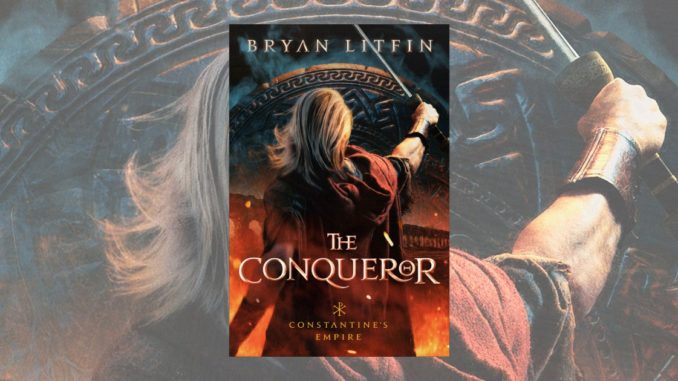
Series: Constantine's Empire #1
Published by Revell on October 13, 2020
Genres: Fiction, Historical, Christian
Buy on Amazon
Goodreads

It is AD 312. Rome teeters on the brink of war. Constantine's army is on the move. On the Rhine frontier, Brandulf Rex, a pagan Germanic barbarian, joins the Roman army as a spy and special forces operative. Down in Rome, Junia Flavia, the lovely and pious daughter of a nominally Christian senator, finds herself embroiled in anti-Christian politics as she works on behalf of the church.
As armies converge and forces beyond Rex's and Flavia's controls threaten to destroy everything they have worked for, these two people from different worlds will have to work together to bring down the evil Emperor Maxentius. But his villainous plans and devious henchmen are not easily overcome. Will the barbarian warrior and the senator's daughter live to see the Empire bow the knee to Christ? Or will their part in the story of Constantine's rise meet an untimely and brutal end?
Travel back to one of the most pivotal eras in history--a time when devotion to the pagan gods was fading and the Roman Empire was being conquered by the sign of the cross.
I knew Bryan Litfin from his scholarly work, his professorship at Moody Bible Institute, and his work with The Gospel Coalition. When I saw that he was writing a historical fiction trilogy set within the early church of Constantine’s Empire, I had two competing thoughts:
- Bryan Litfin’s academic credentials will make this series come to life in a way that most historical fiction could never achieve.
- Bryan Litfin’s academic credentials may overwhelm the story if his desire to convey an accurate historical background supersedes the story.
It’s the catch-22 of historical fiction. You have to set your world appropriately, but also introduce the reader to an unfamiliar world without them getting lost amid all the unfamiliarity. Dr. Litfin begins with a historical note that lists 17 historical figures that appear in the books, follows it with a gazetteer of ancient and modern place names (75 of them), and a glossary (38 terms). The point that comes across, whether Litfin wants it to or not, is that a good deal of care and work is going to be needed to follow this story. This all comes before I’ve read a single page or been introduced to a single character and have no connection to the story to compel me to actually do that work.
Once I got into The Conqueror, the story is pretty solid. The storyline flits between Brandulf, a teen solider, and Flavia, a secret Christian who is part of Roman nobility. Litfin’s storytelling is compelling, but constantly bloated with historical aspects that aren’t immediately crucial to the story. Litfin’s historian mode looms over the fictional story and, as I was afraid, ends up consuming it.
Interestingly, Litfin seems to try to make up for his constant use of Roman phrases by interspersing it with modern ones. Sometimes his language is Shakespearean in its use of formal English. At other times, he’s using modern slang. The end result is a very uneven experience.
One positive thing of note is that Litfin portrays the religious experience and behaviors of the characters very accurately. They are not evangelicals in ancient garb, but are historically accurate in their early Catholicism and syncretism.
Litfin also doesn’t hesitate to highlight to low value of women or the sexual depravity of Rome. I was actually a bit shocked to find so much blatantly sexual material in a Christian fiction book. None of it is necessarily gratuitous, but it’s more than I’m used to seeing in Christian fiction and warrants a mention. I wasn’t necessarily offended by it, but I know many who would be very uncomfortable. Two of the most egregious examples:
- Though she was only fourteen, she has the sensual moves and skimpy outfit of someone much older (p. 323). – I would always be careful about the portraying teenage characters in a sexual light, particularly as part of the narrative and not part of character’s viewpoint. Litfin’s goal is to show the depravity of Rome in having the daughter of Publius dance for the entertainment of those gathered (mirroring Herod in Matthew 14). But there are ways to do that without putting the descriptive image of a sexualized teenager in the minds of readers.
- The horse was a specimen to admire: a rippling and masculine beast with lively eyes, a proud neck, and great, bulbous testicles. A glorious thought popped into Maxentius’s mind: What this creature is among horses, I am among men! (p. 403). – Let’s put aside the fact that Litfin uses colons in successive sentences. WHY DO I NEED TO KNOW ABOUT THE HORSE TESTICLES. I don’t. And if that’s the only way Litfin could think of to show Maxentius’s narcissism…well…yikes.
This book was 200 pages of story writtten in 500 pages. Litfin paints an evocative portrait of ancient Rome and shows readers a Christianity that isn’t at all familiar, but it’s just not a compelling story, it’s bogged down with unnecessary terms and phrases meant to bring authenticity, the characters are inconsistent and caricatured, the content is questionable at best for Christian fiction, the list goes on.
A quick glance at Goodreads and Amazon shows me that I’m not alone in my concerns and criticisms about this book. While this was book one of a trilogy, I’d be surprised if the publisher decides to continue it.
